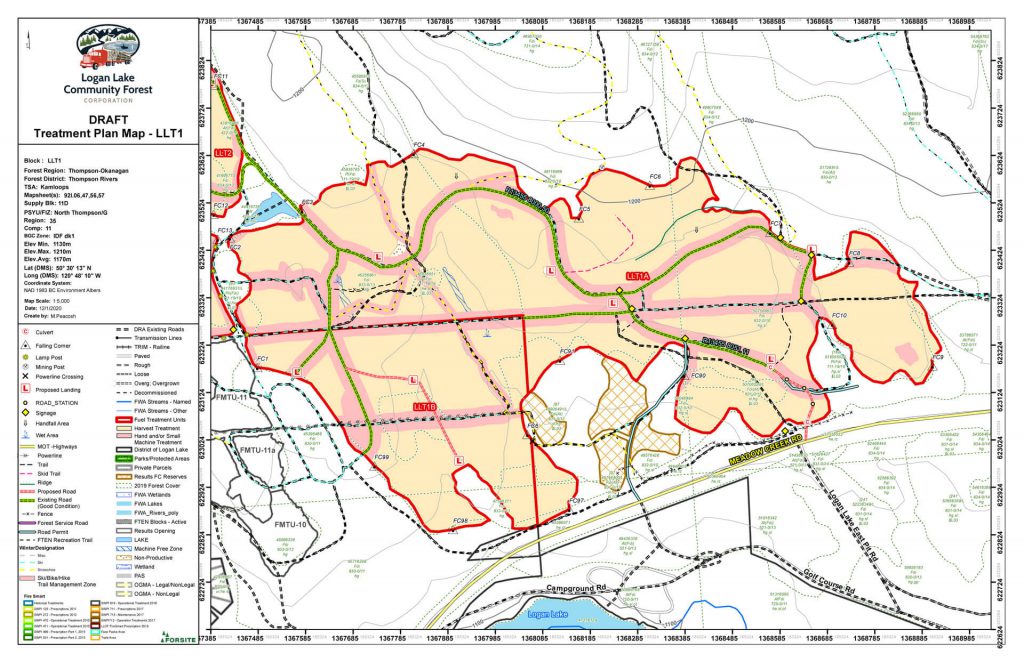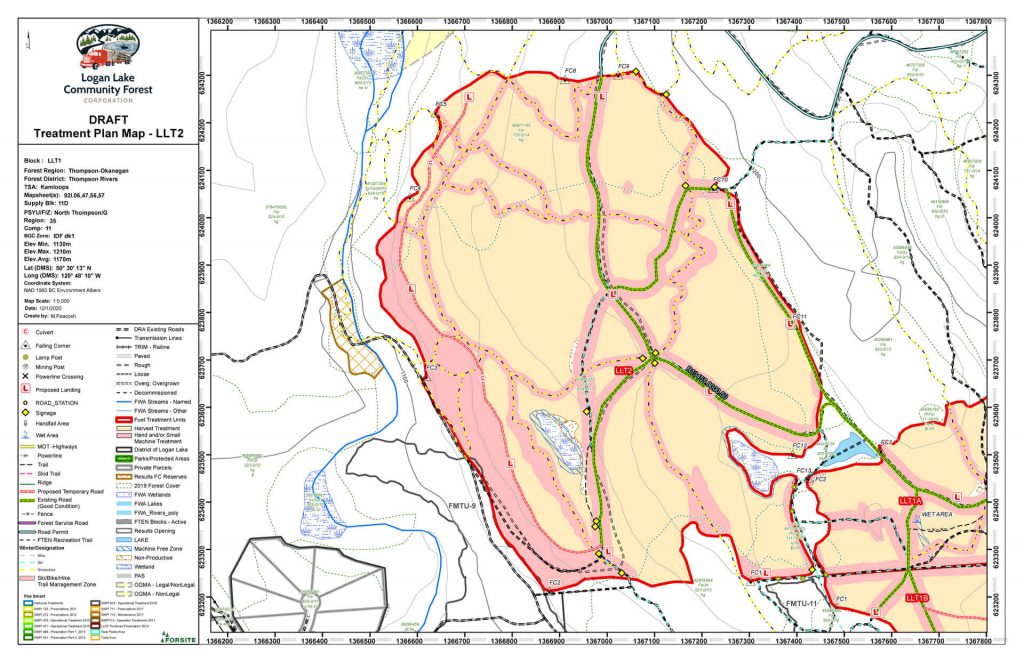Fuel Management in the Logan Lake Trails
Logan Lake Trails Fuel Management – Project Updates
Date: November 29, 2023
Salvage harvesting has started up again in the Tremont Creek wildfire area, creating a partial trail closure in the Logan Lake Recreation and Snowshoe trail system over the winter. The list below shows the trails that are expected to be impacted. The map below also shows the approximate affected locations (shown as diagonal shaded area).
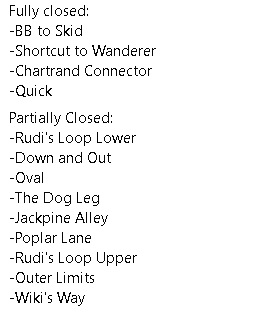
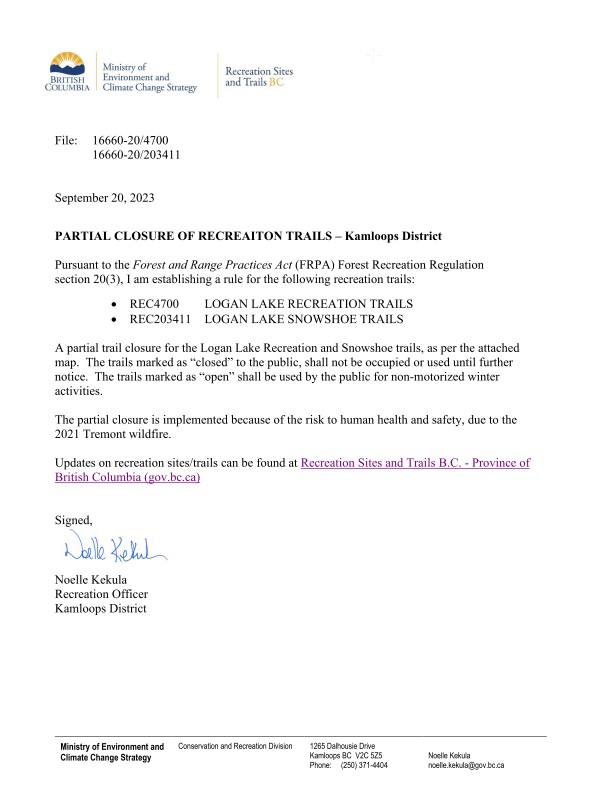
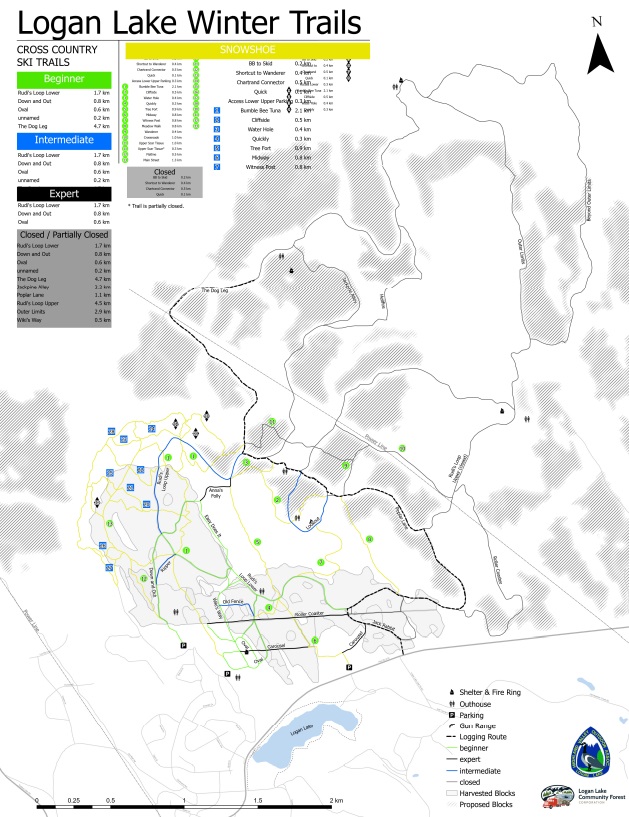
Pile burning is ongoing to the south-west of town, and in the trails area to the north as well where the Youth FireSmart program work took place last summer. Expect to see smoke from time to time!
Date: November 24, 2022
We will be burning debris piles in a few locations around town as part of our operations. There are logging slash piles north of town in the ski trails area, and smaller hand piles from our fuel management projects south of town (by the Mimi Falls Trail).
Burning will take place as early as this week and may extend into early 2023. We will be burning on days with good/fair venting to minimize smoke impacts to the community. If the public sees smoke from areas around town, is likely related to one of our projects.
Date: October 12, 2022
We are beginning active operations again in the Logan Lake Trails area!
There will be work on the trails as far out as the outer shelter on The Dog Leg trail, and grinding and removing of the debris piles within the area already harvested.
Please continue to avoid the entire area to ensure the safety of all parties. Thank you for your patience.
Date: June 7, 2022
Salvage harvest operations in the Logan Lake Trails area are now paused temporarily for the migratory bird nesting period.
No changes to trail closures though! It is still considered an active work site and operations will begin again soon.
Date: May 15, 2022
SPECIAL PUBLIC NOTICE
Logan Lake Trails salvage harvesting – handfalling treatment!
We will be using a handfalling harvest method over the next two weeks (May 16-27) to treat specialized areas alongside the trails.
This carries with it some unique safety considerations because:
- a bystander can’t hear necessarily hand falling equipment being used as easily so could be unaware that it is taking place and approach a falling tree too closely, and
- the hand faller won’t know that an unscheduled bystander in the area and could be distracted / surprised and injure themselves.
Other interesting handfalling facts!
- Hand falling is used in areas that can’t be reached by logging equipment, or areas classified as sensitive.
- Falling trees by hand requires highly specialized skills and a commitment to working safely every day
- In B.C., any worker who fells a tree larger than 15 cm (6 inches) in diameter, at a height of 30cm (15 inches) from the base, must be certified to the BC Faller Training Standard (BCFTS).
Once more, thank you for your continued patience and commitment to community safety in staying out of the trails area.
Date: April 27, 2022
Spring break-up for logging is over and we’re back up in the Trails Area cleaning up after the wildfire.
Date: March 31, 2022
The Logan Lake Trails salvage efforts are paused until the conditions are dry enough to continue operations.
Please note that the area is still closed – thank you for your patience!
Date: March 18, 2022
The initial portion of the access road has been constructed and harvesting on Block LLT1A has begun. Thank you for continuing to respect all safety signage by avoiding any entry into the area!
Date: March 14, 2022
Machinery has now arrived on site after some unexpected delays and they will be starting on constructing access in the coming days.
As always, please contact us if you have any questions or concerns: Garnet Mierau, RPF at gmierau@forsite.ca
Date: January 21, 2022:
PUBLIC NOTICE – LOGAN LAKE TRAILS SALVAGE HARVEST START-UP
We will be starting the Tremont Creek Wildfire salvage harvest in the Logan Lake Trails area, with an anticipated start date the week of February 7, 2022.
Portions of harvesting activities will be taking place next to the community. You may notice increased traffic or machinery operating nearby. There is no increased risk to public safety expected with this work.
Please contact us if you have any questions or concerns: Garnet Mierau, RPF at gmierau@forsite.ca
Please do NOT enter this area to maintain public safety.
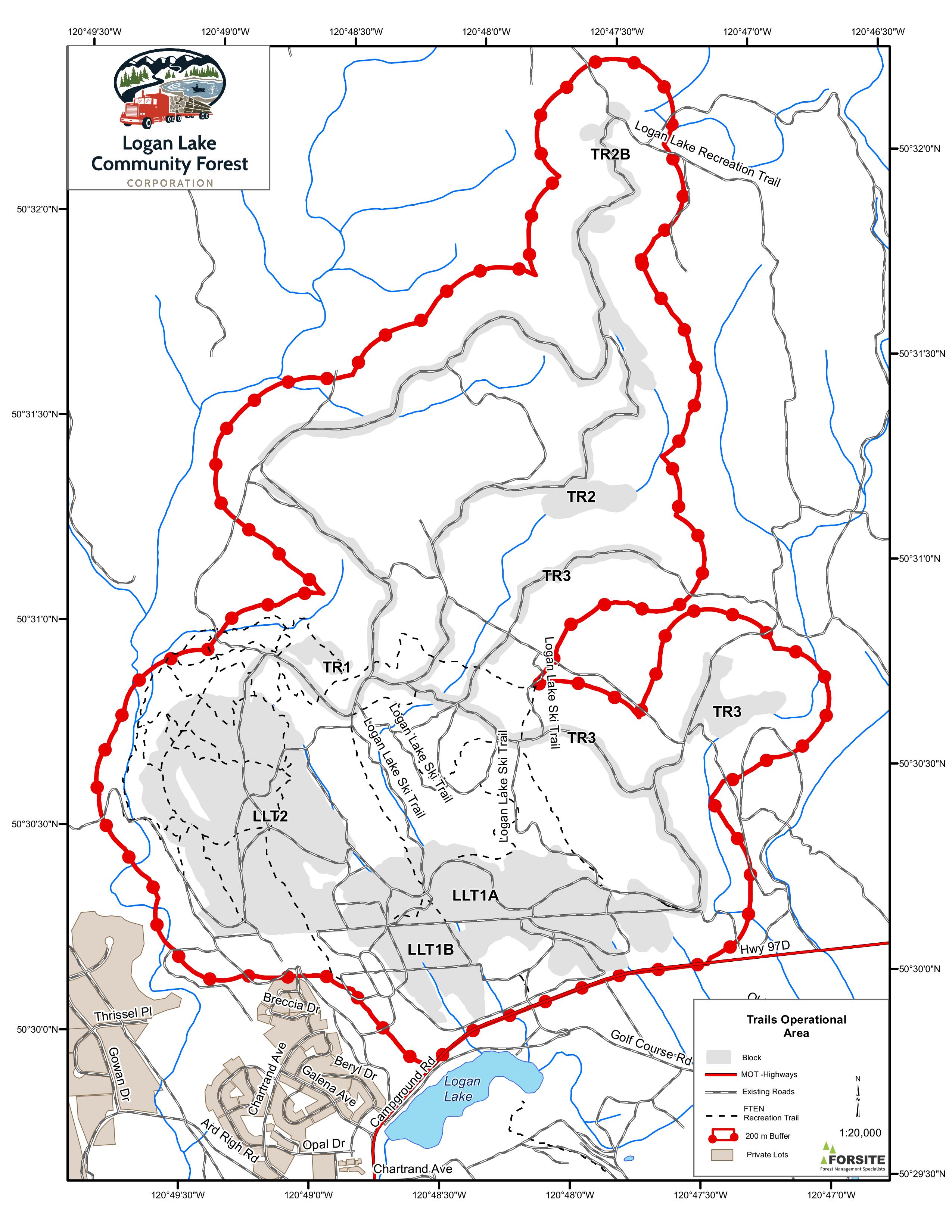
Date: November 9, 2021:
The following video is the recording of the community webinar held on November 4, 2021 reviewing the Tremont Creek Wildfire in the Logan Lake Trails area. The second half of the webinar includes questions directly from the community.
See the bottom of this page for additional webinars and videos.
Date: October 29, 2021
Hello Logan Lake Residents,
We want to thank the community for your patience and support as we work to understand the impacts the Tremont Creek wildfire had on our community and the community forest. We will be hosting an online community webinar to discuss the impacts of the fire and our planned response, including in the Logan Lake Trails area.
We encourage everyone to attend this event to learn more and ask questions. The webinar will be recorded and posted to this webpage.
| Event | Wildfire Recovery in the Logan Lake Trails |
| Date | November 4th, 2021 |
| Time | 5:00 to 6:00 pm |
| Webinar Access | Microsoft Teams (clickable link) |
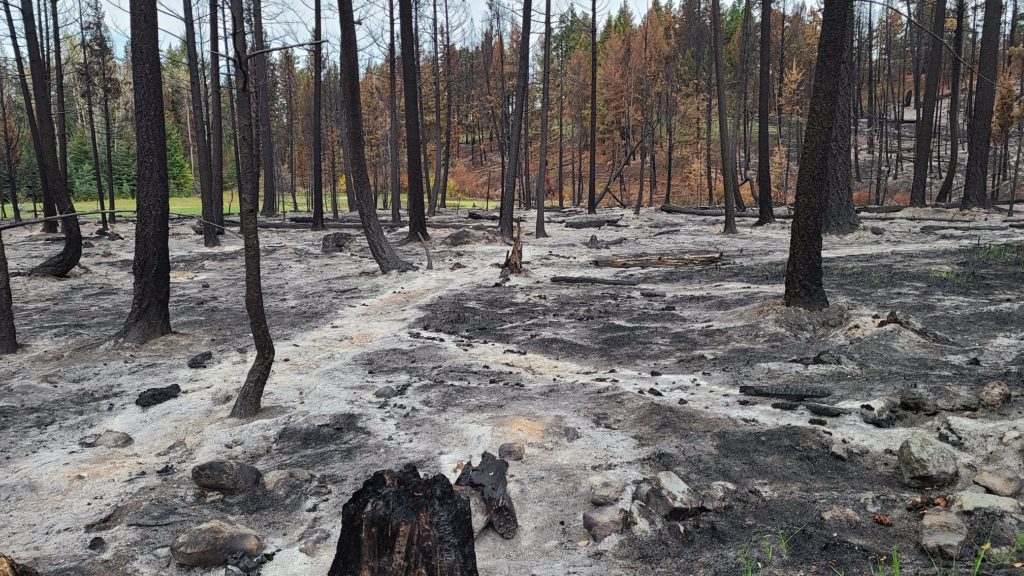
Date: July 27, 2021
Hello Logan Lake Residents,
During this intense wildfire season, we hope that everyone is staying safe and healthy. We wanted to provide an update to the community about our fuel management project in the Logan Lake Trails area:
- We are in the process of finalizing our plans that will be posted to the LLCF website and shared with the community.
- We are continuing engagement with the Highland Valley Outdoor Association (HVOA) with the goal of co-managing the implementation of the harvesting and fuel treatment work in the Trails area. Through HVOA’s input on this process, we have made several changes to our plans to manage for the recreation trails (including trail buffers/no harvest areas, timing operations to avoid peak winter recreation seasons, etc.). We have recently engaged with a professional biologist about management for key bird species that have been noted in the treatment area.
- We have deferred the harvesting in treatment unit LLT2 (northwest portion of the project area) as this is generally the area of highest concern with the public due to the density of trails and significant viewpoints. This treatment is likely to move ahead in 2022 once the work is demonstrated in other areas and discussed further with HVOA.
- Note: We are still doing some work along the western flank of LLT2, but this is just hand crews and small equipment doing a light cleanup, and no logging will occur in this unit.
- We are planning to initiate harvesting in LLT1 (eastern portion of the planned treatment) and assess the results of treatments with the HVOA to gain a better understanding of the final results before considering further work in LLT2.
- Currently, our goal is to initiate harvesting and fuel treatments this fall (tentatively in October). The wildfire season we are experiencing may delay the startup of this work as contractors have been delayed from projects due to the fire season shutdown. We will still do everything possible to see treatments initiated as soon as possible in order to respond to the fuel loading and associated wildfire risks.
For any questions about the project, please contact Garnet Mierau, RPF at gmierau@forsite.ca or Randy Spyksma at rspyksma@forsite.ca.
Regards,
Logan Lake Community Forest Management Team
Please find the attached Information Sheet/ Frequently Asked Questions on the planned treatments in and around the Logan Lake Trails.
The landscape around Logan Lake is a high wildfire risk as identified in the Logan Lake Wildfire Risk Management Plan (2018) due to high fuel loading (dense forests), its proximity to the community itself (human life and safety) as well as other values in the area (e.g. critical infrastructure, recreation values). Fire suppression activities over the past century along with the more recent Mountain Pine Beetle epidemic have resulted in unnatural ecosystems that need to be treated in order to reduce the wildfire risk to the community. There is potential for catastrophic wildfires that could have adverse impacts to the community, trail users, recreation infrastructure, forest health, and safety of wildfire suppression crews.
Fuel Treatment Approach
In order to mitigate this risk, the Logan Lake Community Forest (LLCF) is planning a two phased approach in the Logan Lake Trails area:
1. Select Harvest
Partial cutting (thin from below) will be used to remove a component of standing trees and increase tree canopy spacing in order to manage the crown fuels. Select harvesting will focus on removal of smaller trees and leave behind the larger trees. Harvesting will retain over 60% of the volume of mature timber (trees > 17.5 cm diameter) and the post-harvest stand will be mainly composed of older/thick barked Douglas-fir trees to create a more wildfire resilient forest. All deciduous trees will be retained.
2. Follow-up Fuel Treatment
Hand crews and/or small equipment will be used to prune the remaining trees and clean up surface debris. This treatment will reduce the potential for a surface fire to spread along the ground or move up into nearby tree canopies (i.e. torching).
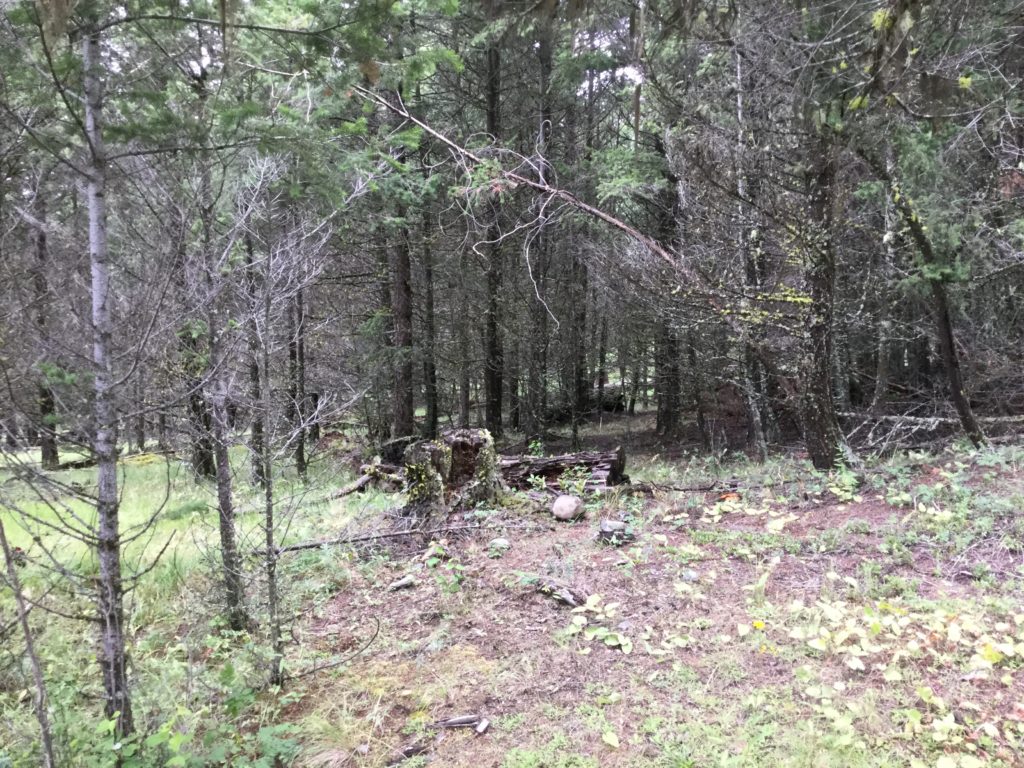
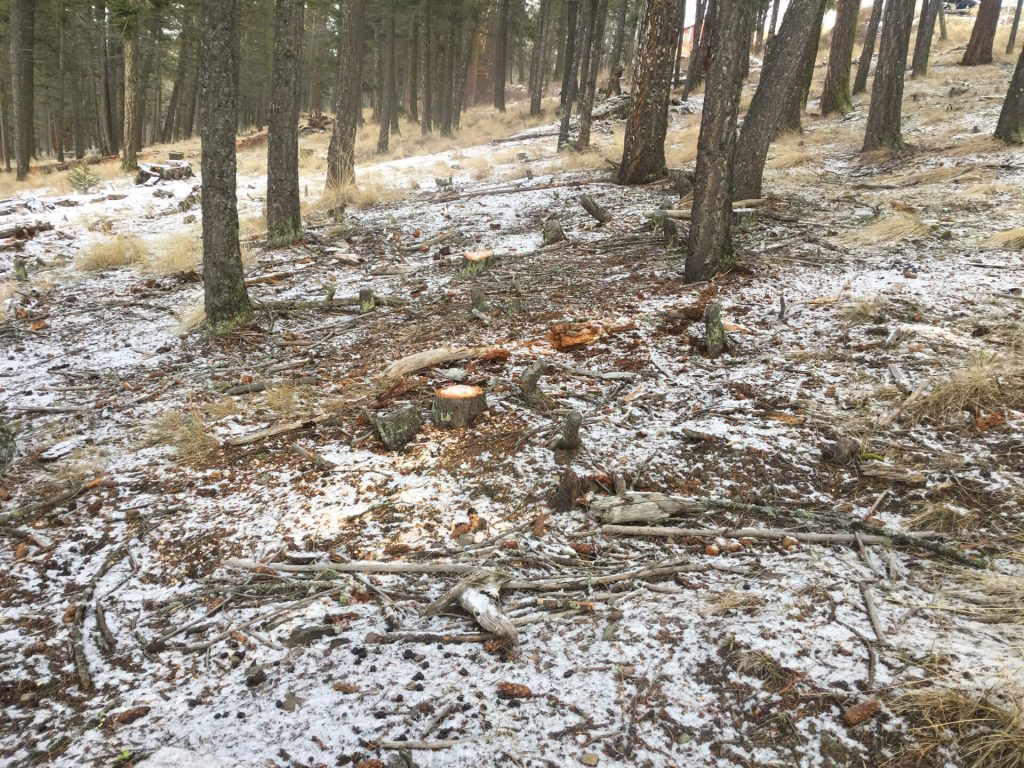
Key Facts
- Treatments cover approximately 130 hectares of area adjacent to the community.
- Treatments are designed to create a landscape-level fuel reduction to address the risk of wildfire approaching from north of the community or quickly spreading from the community into the Trails area.
- Overall, the treatments will result in a significant reduction in the potential severity of wildfire next to the community. This will:
- improve safety for wildfire suppression crews responding to a wildfire, resulting in an overall reduction in risk to the community,
- improve chances of tree survival,
- reduce potential impacts to human life, and
- reduce impacts to recreation trails and infrastructure.
Treatment Summary
The recreation trail network and associated infrastructure within the project area has been developed and managed by the Highland Valley Outdoor Association (HVOA) for over 30 years. The trail network represents a significant investment of volunteer labour and funds, and is of incredible importance to the entire community, HVOA, the LLCF, and public trail users. The LLCF has been involved in detailed discussions with HVOA for over 4 years in development of the current treatment plans to balance wildfire risk reduction with recreation values.
The following measures are proposed by the LLCF to manage for recreation values while ensuring that suitable wildfire risk reduction measures are being completed:
Timing of Harvest Operations
Treatments are planned to commence late summer/early fall to minimize overlap with peak summer and winter recreation seasons. Phase 1 harvest operations are restricted from December 1 to March 31 to protect the winter recreation season.
Trail Management Zones
- Special trail management zones will be established 20 meters on either side from the edge of cross country ski trails and 10 meters from the edge of single-track hike/bike trails.
- No machinery will be allowed within these trail management zones except at designated crossings.
- All live mature trees will be retained except for danger trees (i.e. trees that pose a safety hazard to work crews or recreationalists that are assessed by a qualified professional).
- Equipment may reach into trail management zones to remove blown down trees as long as live standing trees are not impacted.
- Understory hand and/or small machine treatments are permitted within trail management zones (i.e. spacing of small understory trees, pruning of tree branches to 3 meters off the ground, surface debris cleanup).
Areas Requested as No Harvest Zones
Three areas of key importance to HVOA were identified and excluded from the total harvest area:
- The ‘Million Dollar View’ (southern end of LLT2).
- The hillside down slope of the proposed road in LLT2 (along the western flank).
- The small area along Bumblebee Trail and near the junction of the Hippity Dippity Trail.
Understory hand and/or small machine treatments are permitted within these No Harvest Zones (i.e. spacing of small understory trees, pruning of tree branches to 3 meters off the ground, surface debris cleanup).
Access Control
Access control is being managed by creating a single access point to the Trails area off the main highway (Meadow Creek Road) in the southern portion of LLT1. All commercial equipment, logging trucks and treatment crews will access the Trails area from this main point. This entry point will be signed and public use prohibited. Upon completion of treatments, this access will be deactivated (i.e. ditched or barricaded as needed) and the fence line rebuilt. In addition, the western flank of LLT2 that was noted by HVOA as a possible access for motorized vehicles has been placed into a ‘no harvest zone’ (i.e. hand/small machine fuel treatment only). The Logan Lake Community Forest will work with the District Recreation Officer to manage access concerns to the Trails area.
The existing cross-country ski trails were developed on top of historic logging roads. There will be 7.5 km of existing trails that will be utilized for the proposed treatments to reduce the need to build new roads. Road upgrade activities will be kept as minimal as possible while meeting operational/safety needs to maintain trail integrity post-harvest. Any areas of disturbed soil will be rehabilitated post-harvest and roads will be returned to a condition that will continue to support their use as a trail.
There are 18 landings proposed in the treatments: 8 in LLT1 and 10 in LLT2. There is 1.7 km of new road to be constructed (see the maps for proposed road location). This includes 400 metres of road in LLT1 and 1.3 km of road in LLT2. The proposed road in treatment area LLT2 is required to allow access to the northern extent of the treatment area. Once operations are complete:
- The road will be rehabilitated including soil de-compaction, grass seeding and planting as needed.
- Drainage control (e.g. water bars/cross ditches) will be used to maintain natural drainage patterns.
- All recreation trail crossings will re-established post-harvest.
Harvest Parameters
The intention is a ‘thin from below’ style harvest to remove mainly the smaller and younger stems that are more susceptible to impacts from fire. Some of the smaller stems will be retained to ensure a multi-age class stand for biodiversity.
Harvest Specifications:
- Approximately 40% harvest and 60% retention of trees >12.5 cm DBH (Layer 1 trees)
- All dead conifers between 12.5 – 39.9 cm DBH (diameter at breast height)
- All lodgepole pine, live or dead
- All dead spruce >40 cm DBH, except high value wildlife trees (noted below)
- All assessed and marked danger trees (including any hazard trees requested by HVOA along ski trails)
- Volume of timber estimated for removal = 7,000 cubic metres (~140 logging trucks)
Retention Specifications:
- All dead Douglas-fir, ponderosa pine and spruce >40 cm DBH as wildlife trees (unless unsafe)
- All live ponderosa pine >12.5 cm DBH (unless unsafe)
- All deciduous species (live + dead, unless unsafe)
- Live Douglas-fir and spruce as follows:
- 95% of stems >40 cm DBH (trees over this size class will only be removed for operational or safety purposes)
- 50% of stems between 27.5 – 39.9 cm DBH
- 25% of stems between 12.5 – 27.4 cm DBH
Effectiveness Monitoring and Maintenance
An important component of LLCF’s wildfire risk reduction program is long-term effectiveness monitoring and maintenance of treated areas. The LLCF will be implementing a long-term monitoring program post-treatment to determine the need and frequency of future activities. The proposed treatments in the Trails area represent a ‘first pass’ and additional work in the future may be undertaken to address new hazards such as increased grass growth where forest cover is removed or tree mortality caused by windthrow or pests such as Douglas-fir bark beetle. Forests are dynamic ecosystems and long-term management activities may be required to maintain the Trails area in a state that mitigates wildfire risk to the community, maintains the recreation experience, and allows for proper ecosystem function. These management activities may include:
- Further select harvesting,
- Further hand and/or small machine fuel treatments,
- Targeted grazing to manage grass fuels, and
- Prescribed fire to manage grass fuels and fine woody debris.
The LLCF will be continuing to work with HVOA and the District of Logan Lake as this important project moves forward. This engagement will include regular conversations and site visits during the implementation of the proposed treatments to ensure our work is proceeding as planned.
Calendar of Additional Community Engagement
Feedback on the Logan Lake Trails is welcome at any time. Please use the feedback form on our website or contact the Community Forest Management directly by emailing Garnet Mierau at gmierau@forsite.ca
The following key initiatives and events have been planned to enhance our community outreach and provide numerous opportunities for engagement.
| Timeline | Engagement Activity |
| Ongoing | Treatment information provided on LLCF website, Facebook, and YouTube video. An online feedback form is available on our website for you to submit your comments, as well as contact information for our Forest Management Team to speak with us directly. |
| Spring 2021 (COVID dependent) | Field day to review proposed treatments in a previously treated area to show what the intended outcome will be. Date to be determined based on snow-free conditions. |
| Late Summer / Fall 2021 | Potential start to the activities – scope to be determined. |
Additional Information
The following video is the recording of the community webinar held on February 23, 2021 reviewing the fuel management treatments in the Logan Lake Trails area. The second half of the webinar includes questions directly from the community.
The Logan Lake Community Forest has prepared a helpful video that describes wildfire risk and approaches to sustainable forest management that responds to risk while balancing management of other resource and community values. In particular the video discusses the proposed fuel management treatments in the trails area to support community engagement and understanding.

